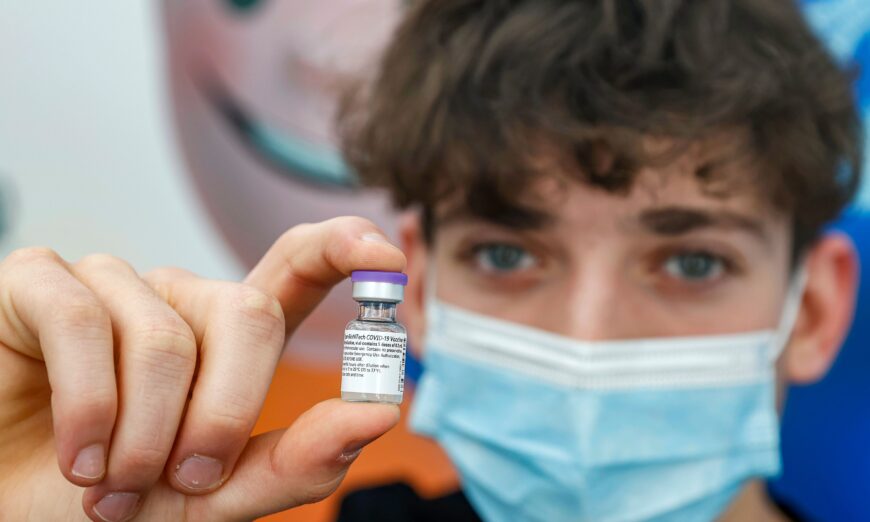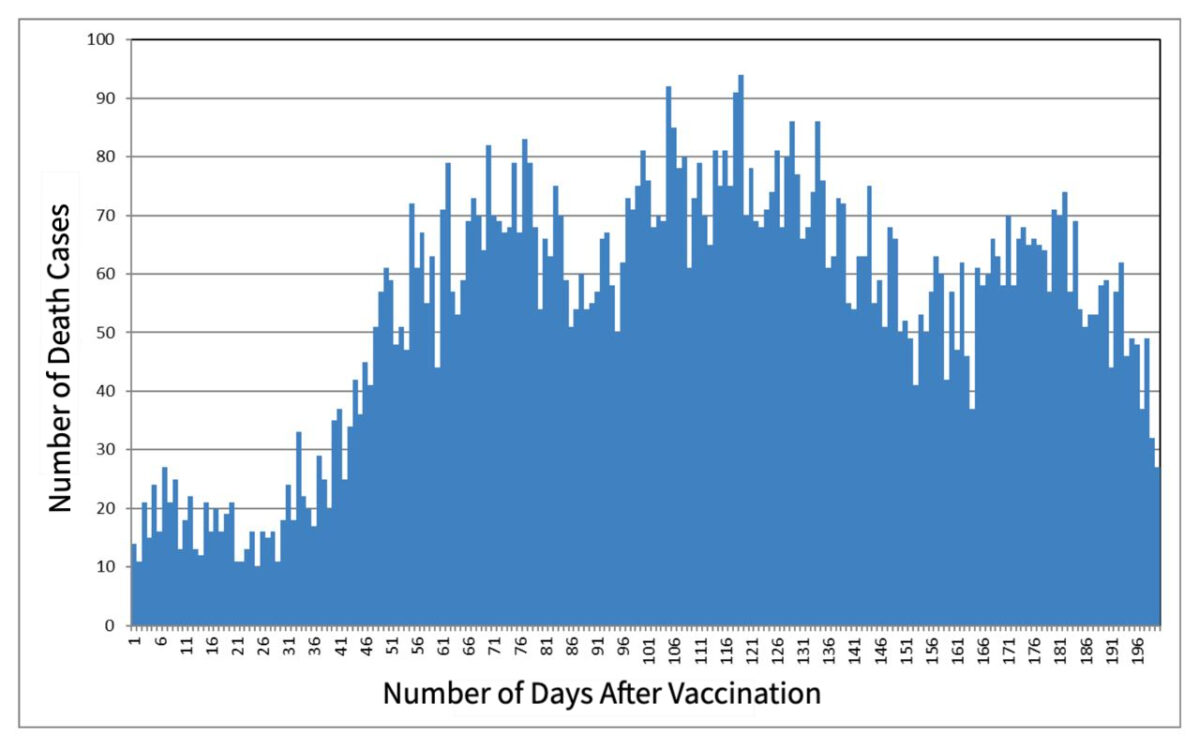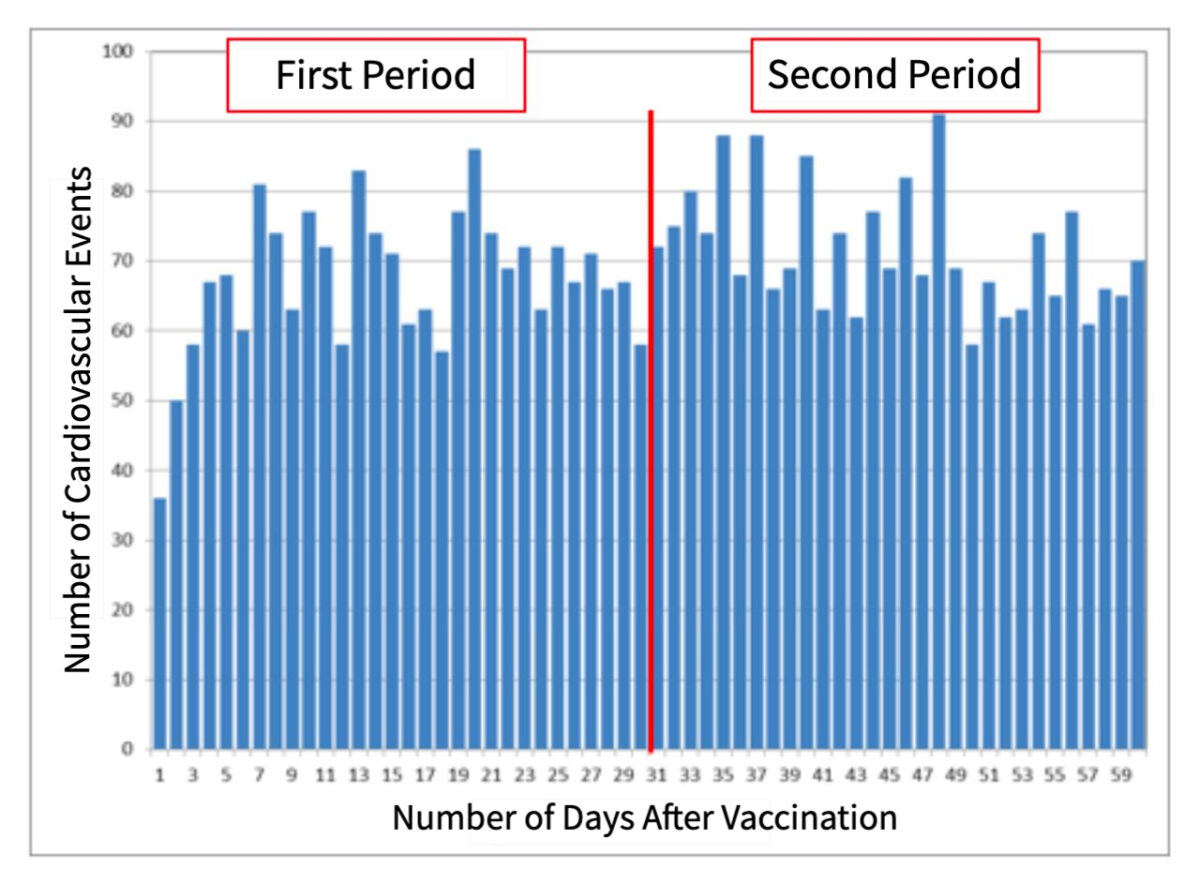
What is clear is that the negative response is not immediate for almost all folks, but the induced weakness opens the door for later impacts. Think immunity decline and you have it.
Again, no one is saying what it is and we still get obfuscation on the visible data.
Do we also have to promise sudden death for this behavior in order to get the real science?
One expert against hundreds of paid report writers.
Israeli Ministry of Health Produces Controversial Report on COVID-19 Vaccine Mortality
Mar 15 2023
A 16-year-old teenager receives a dose of the Pfizer-BioNtech COVID-19 vaccine at Clalit Health Services, in Israel's Mediterranean coastal city of Tel Aviv on Jan. 23, 2021. (Jack Guez/AFP via Getty Images)
https://www.theepochtimes.com/israeli-ministry-of-health-produces-controversial-report-on-covid-19-vaccine-mortality_5119326.html?u
An Israeli Ministry of Health (MOH) study could not determine mortality risk from Pfizer’s COVID-19 vaccine and found no evidence of cardiovascular events after COVID-19 vaccination, the MOH said, though an outside expert said the conclusions are contrary to the data.
The study (pdf) was published in Hebrew on the MOH website on Feb. 27. The Epoch Times reviewed and translated the report.
Researchers examined people who passed away or were hospitalized due to an acute cardiovascular event after receiving a Pfizer vaccine.
According to the authors, the MOH decided to conduct the study after other scientific publications did not find a connection between cardiovascular events and COVID-19 vaccination, “except for one single report,” referring to a Florida study that found “a modestly increased risk for cardiac-related mortality 28 days following vaccination,” among residents aged 18 years or older. But other research, including Israeli papers, has found a risk of heart inflammation after vaccination.
The MOH chose the self-controlled case series (SCCS) design for their study, similar to the Florida study.
The advantage of the SCCS design, according to the MOH paper, is that “possible differences between the vaccinated and non-vaccinated population are neutralized, as well as variables that may affect the results, such as comorbidity and behavioral differences.”
Non-vaccinated individuals were not included in the study. Only individuals who were vaccinated with two doses of the Pfizer vaccine were included.
Each vaccinated person was followed for a total of 200 days after receiving the second dose. The study mainly compared the rate of events within 30 days of receiving the vaccine to the rate in the following 30 days, which served as the control period.
The SCCS design was originally for a medicine given one time. The authors of the Florida study modified it as a primary series of Pfizer’s messenger RNA (mRNA) vaccine is two doses. Adverse outcomes after the first dose were ignored for the Israeli study, which covered Jan. 11, 2021, through the end of October 2021.
Mortality Risk
The researchers examined cases of individuals who died during the 60-day follow-up period after vaccination with the second dose. People who tested positive for COVID-19 were excluded.
Out of the 1,815 deaths in this group, 540 cases were in the first 30 days versus 1,275 cases in the second period. There was more than twice the number of deaths in the second period.
The authors said in the report that according to the null hypothesis, there is no difference in the risk between the two periods. So the events will be uniformly distributed over the duration of the follow-up.
The researchers noted that more events in the first period would support the hypothesis that there was an increased risk of an event in the period close to the administration of the vaccine.
Diagram 1: Distribution of death cases according to the number of days post-second vaccination. English translation by The Epoch Times. (Israel Center for Disease Control and The Gertner Institute)
“It looks like there are much fewer mortality events in the first period (540) compared to the second period (1,275),” according to the authors.
The researchers attributed the results to “a bias called the healthy vaccinee effect,” which refers to people who get vaccinated generally being healthier than the general population.
“It was not possible to determine whether there exists a higher mortality risk 30 days following the vaccine,” they wrote.
The findings are “actually quite inconsistent with the healthy vaccinee effect,” Retsef Levi, a professor at the Massachusetts Institute of Technology Sloan School of Management, told The Epoch Times.
The healthy vaccinee effect is usually used to compare one group to another and not to itself, he added, calling it “a negative control approach.”
Usually, when comparing vaccinated to non-vaccinated people, it is likely to find a higher death rate among the unvaccinated, since they include unhealthy individuals who could not take the vaccine due to their health status, according to Levi, an expert in risk management and health systems. While researchers hypothesized there should be higher mortality in the first 30 days, they found much higher mortality in the second period, but the healthy vaccinee effect does not account for such a large increase, he said.
The findings could be more consistent with some delay in mechanisms that might lead to death at a later time, Levi said, describing them as “very, very disturbing.”
In addition, the pattern in the death cases over the follow-up period does not match the healthy vaccinee effect, he said, adding that usually what is seen in the case of the influenza vaccines is a slight decrease in death rate followed by a rapid increase and then it stays flat.
“One possibility that needs to be considered is a delayed allergic response (possibly due to repeat exposure to PEG),” wrote Dr. Michal Haran, a senior hematologist, in a post on Twitter. PEG refers to polyethylene glycol.
“Such a local response has been described, following the mRNA vaccine,” Haran said in another post linking to a study that examined skin reactions to the mRNA vaccines.
“It looks like there are much fewer mortality events in the first period (540) compared to the second period (1,275),” according to the authors.
The researchers attributed the results to “a bias called the healthy vaccinee effect,” which refers to people who get vaccinated generally being healthier than the general population.
“It was not possible to determine whether there exists a higher mortality risk 30 days following the vaccine,” they wrote.
The findings are “actually quite inconsistent with the healthy vaccinee effect,” Retsef Levi, a professor at the Massachusetts Institute of Technology Sloan School of Management, told The Epoch Times.
The healthy vaccinee effect is usually used to compare one group to another and not to itself, he added, calling it “a negative control approach.”
Usually, when comparing vaccinated to non-vaccinated people, it is likely to find a higher death rate among the unvaccinated, since they include unhealthy individuals who could not take the vaccine due to their health status, according to Levi, an expert in risk management and health systems. While researchers hypothesized there should be higher mortality in the first 30 days, they found much higher mortality in the second period, but the healthy vaccinee effect does not account for such a large increase, he said.
The findings could be more consistent with some delay in mechanisms that might lead to death at a later time, Levi said, describing them as “very, very disturbing.”
In addition, the pattern in the death cases over the follow-up period does not match the healthy vaccinee effect, he said, adding that usually what is seen in the case of the influenza vaccines is a slight decrease in death rate followed by a rapid increase and then it stays flat.
“One possibility that needs to be considered is a delayed allergic response (possibly due to repeat exposure to PEG),” wrote Dr. Michal Haran, a senior hematologist, in a post on Twitter. PEG refers to polyethylene glycol.
“Such a local response has been described, following the mRNA vaccine,” Haran said in another post linking to a study that examined skin reactions to the mRNA vaccines.
Appendix 1, Diagram 3: Distribution of death cases according to the number of days post-second vaccination up to 200 days. English translation by The Epoch Times. (Israel Center for Disease Control and The Gertner Institute)
200-Day Follow-Up Period
The researchers also presented data on deaths over the 200-day follow-up period.
“In the diagram, it appears that the [healthy vaccinee] bias disappears approximately after 50 days.
Afterwards, there are waves that do not seem suitable for a significant long-term effect of the vaccine,” the researchers wrote.
These waves cannot be explained by the normal seasonality as seen in 2019, they added. “It is possible that they are related to the COVID-19 waves and the burdens on the health system.”
The exclusion criteria for this study prevented individuals who were COVID-positive from participating, so the researchers are contradicting themselves, said Levi.
They also “did not report what normal mortality rates are for this population,” he added.
The researchers have not done matching of this study population to previous years to learn the normal death patterns of this population. They haven’t “done many things that you would expect them to do,” he said.
“What is seen is mortality over time of the particularly healthy people that got the vaccine,” Haran said in a Facebook post.
This could be sensitization and repeated exposure to a material that induces a response from the immune system. It is well known when exposed to latex and other materials such as formalin, polyethylene glycol, and more, the doctor wrote.
The mechanism is different than the “classical” anaphylactic reaction and that’s why it’s less known, even though it might not be less dangerous, she added.
The conclusion of those who wrote the report is that since there is no higher death in the first month—as we would expect to see as an adverse event to a medical procedure—that proves that the vaccine does not cause death, she wrote. The explanation the authors gave for the fact that the mortality at the beginning is lower than expected is the healthy vaccinee effect.
They forgot to ask the question, “What would cause these people (that their life expectancy is high) to die in the following weeks?” she asked.
Haran wrote that if her explanation is true, maybe what is needed to save lives are not defibrillators but EpiPens, referring to an auto-injectable device for the emergency treatment of life-threatening allergic reactions (anaphylaxis).
These waves cannot be explained by the normal seasonality as seen in 2019, they added. “It is possible that they are related to the COVID-19 waves and the burdens on the health system.”
The exclusion criteria for this study prevented individuals who were COVID-positive from participating, so the researchers are contradicting themselves, said Levi.
They also “did not report what normal mortality rates are for this population,” he added.
The researchers have not done matching of this study population to previous years to learn the normal death patterns of this population. They haven’t “done many things that you would expect them to do,” he said.
“What is seen is mortality over time of the particularly healthy people that got the vaccine,” Haran said in a Facebook post.
This could be sensitization and repeated exposure to a material that induces a response from the immune system. It is well known when exposed to latex and other materials such as formalin, polyethylene glycol, and more, the doctor wrote.
The mechanism is different than the “classical” anaphylactic reaction and that’s why it’s less known, even though it might not be less dangerous, she added.
The conclusion of those who wrote the report is that since there is no higher death in the first month—as we would expect to see as an adverse event to a medical procedure—that proves that the vaccine does not cause death, she wrote. The explanation the authors gave for the fact that the mortality at the beginning is lower than expected is the healthy vaccinee effect.
They forgot to ask the question, “What would cause these people (that their life expectancy is high) to die in the following weeks?” she asked.
Haran wrote that if her explanation is true, maybe what is needed to save lives are not defibrillators but EpiPens, referring to an auto-injectable device for the emergency treatment of life-threatening allergic reactions (anaphylaxis).
Diagram 2: Distribution of cardiovascular events according to the number of days post-second vaccination. English translation by The Epoch Times. (Israel Center for Disease Control and The Gertner Institute)
Cardiovascular Events
The researchers examined cases of individuals who were hospitalized due to an acute cardiovascular event (myocardial infarction, stroke, and thromboembolic event) during the 60-day follow-up period after vaccination with the second dose, and who were not positive for COVID-19.
Out of 4,057 cases, 1,979 occurred in the first period compared to 2,078 in the second, which was not statistically significant, they said.
The results “did not indicate an excess risk” during the 1–30 day time period compared to the 31–60 day time period, according to the researchers.
“No indication of an increased risk was found in the time period of 30 days after vaccination compared to the time period of 31–60 days, nor in the additional sensitivity analyses,” the authors wrote.
They noted that they did not include myocarditis events because that was a known risk for the COVID-19 vaccine, especially in young men.
The researchers do not detail the specific diagnoses they chose to examine in this study but only use general terms.
“When you talk about diagnoses, you can’t just use the name. Each of these names includes a great many sub-diagnoses. We can’t know what they included and what they didn’t,” Levi said.
In addition, they examined only hospitalizations. Cases of individuals who ended up in the emergency room, clinics, and death cases that occurred outside of the hospital were not included, he said.
The researchers did not include myocarditis in this analysis. They only accessed it in a separate analysis attached to the report as appendix two, “which shows a dramatic signal,” according to Levi.
When myocarditis events were included in the processing “there is an increased risk to the [cardiovascular] event in the first period compared to the second period, in the younger age group,”
Cardiovascular Events
The researchers examined cases of individuals who were hospitalized due to an acute cardiovascular event (myocardial infarction, stroke, and thromboembolic event) during the 60-day follow-up period after vaccination with the second dose, and who were not positive for COVID-19.
Out of 4,057 cases, 1,979 occurred in the first period compared to 2,078 in the second, which was not statistically significant, they said.
The results “did not indicate an excess risk” during the 1–30 day time period compared to the 31–60 day time period, according to the researchers.
“No indication of an increased risk was found in the time period of 30 days after vaccination compared to the time period of 31–60 days, nor in the additional sensitivity analyses,” the authors wrote.
They noted that they did not include myocarditis events because that was a known risk for the COVID-19 vaccine, especially in young men.
The researchers do not detail the specific diagnoses they chose to examine in this study but only use general terms.
“When you talk about diagnoses, you can’t just use the name. Each of these names includes a great many sub-diagnoses. We can’t know what they included and what they didn’t,” Levi said.
In addition, they examined only hospitalizations. Cases of individuals who ended up in the emergency room, clinics, and death cases that occurred outside of the hospital were not included, he said.
The researchers did not include myocarditis in this analysis. They only accessed it in a separate analysis attached to the report as appendix two, “which shows a dramatic signal,” according to Levi.
When myocarditis events were included in the processing “there is an increased risk to the [cardiovascular] event in the first period compared to the second period, in the younger age group,”
the authors noted.
Appendix 2, Diagram 4: Distribution of cardiovascular events, including myocarditis, according to the number of days post-second vaccination in the zero–29 age group. English translation by The Epoch Times. (Israel Center for Disease Control and The Gertner Institute)
Cardiovascular Events in Young People
When the authors stratified the analysis by age groups they concluded that “there is no indication of an increased risk in the first period in any age group.”
In the younger age group (0–29 years) “there seems to be a high point estimate,” but the numbers are very small (20 cases in the first period compared to 12 in the second period), the authors wrote, adding that no statistical significance was found.
For the 0–29 age group, the odds risk with a 95 percent confidence interval was 1.75 (0.82–3.72).
However, children 11 years of age and under were not eligible for the COVID-19 vaccine in Israel during the time period of this study.
“There is a signal of a 70 percent increase in the risk of hospitalization,” Levi said, “but they only claim that the signal is not specifically significant because there are not many cases.”
As for the age groups’ analysis, he said the researchers should have examined each decade separately to find the right breakdown for age groups.
There is a signal of a potential effect of the vaccine on cardiovascular events among young people, said Levi.
This study is lacking basic data such as analysis of what happened after the first vaccination, mortality due to COVID-19, and the total number of people included in this study, he concluded.
The MOH study was conducted and authored by the Israel Center for Disease Control (ICDC), and The Gertner Institute for Epidemiology and Health Policy Research.
The ICDC referred The Epoch Times to the MOH for comment.
The MOH, The Gertner Institute, and Pfizer did not reply to requests for comment.




No comments:
Post a Comment